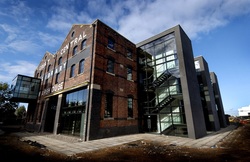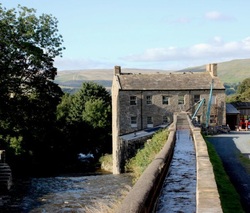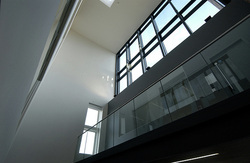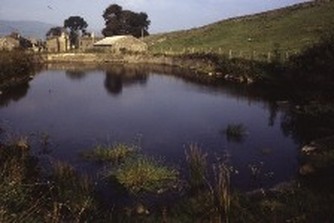Case Studies
University of Lincoln Library

- Built 1907
- In 2005, the building was awarded the Gold & Silver award for Conservation and Regeneration from the Royal Institution of Charted Surveyors in Leicester.
- The Library has also gained the Gold award from the Royal Institution of British Architects.
History & Background:
The University of Lincoln library was originally built as a industrial railway goods warehouse in 1907 by the Great Central Railway company. The ‘great central warehouse’ was a key point on the busy Lincolnshire rail line and offered important and accessible storage for items in transit.
However, with the decline of train usage for both personal and industrial use the need for warehouse buildings such as this were reduced dramatically, eventually turning the unit to a Builders Warehouse and storage firm in the second half of the twentieth century. In 1998 the building began to fall into disrepair, but the University soon took to renovating the building into it’s current built state and usage, with it’s opening in 2004.
The overall conversion cost £5 million to update it from the old Victorian storage warehouse to the newer teaching, learning and research building used by the majority of the Brayford campus.
Sustainability:
There are many aspects of the existing building that have been kept, as they can work with the newer techniques to achieve sustainable results and efficient use. For example, the masonry has been largely kept as it as part of the heritage of the building. However, with appropriate windows and insulation (in the roof) applied it has achieved reliable results which are cost effective to run and also provide a useable space.
To the rear of the building is one of the two main staircases, as seen on the floor plans below. The obvious advantage of using newer techniques of building and modern materials, in this case suitable glass, have continued to make the building worthwhile to use. Furthermore, adding this section towards the back of the building offers not only centralised ventilation and easy to find access routes, but also allow a large amount of useable daylight to enter the space for it’s users. Also, with the group work rooms added to either side of the building, more light is allowed to enter the space through the access points of the building.
As seen in the Flickr link below, the building mostly already had it’s own structure, so minimal changes were made to floor levels. Despite this, the roof was renewed during the renovation, and this was adapted using more modern materials to minimise heat loss/gain during the year.
An important aspect of this building to remember is it’s use as a public space for the majority of the University, and the equipment which runs throughout the day. Large amounts of computer and I.T network devices require a high amount of power. This existing building, at this time, does not provide any viewable sources of renewable energy. However, with such a recent renovation with modern technologies, the building can conserve waste in other areas.
The University of Lincoln library was originally built as a industrial railway goods warehouse in 1907 by the Great Central Railway company. The ‘great central warehouse’ was a key point on the busy Lincolnshire rail line and offered important and accessible storage for items in transit.
However, with the decline of train usage for both personal and industrial use the need for warehouse buildings such as this were reduced dramatically, eventually turning the unit to a Builders Warehouse and storage firm in the second half of the twentieth century. In 1998 the building began to fall into disrepair, but the University soon took to renovating the building into it’s current built state and usage, with it’s opening in 2004.
The overall conversion cost £5 million to update it from the old Victorian storage warehouse to the newer teaching, learning and research building used by the majority of the Brayford campus.
Sustainability:
There are many aspects of the existing building that have been kept, as they can work with the newer techniques to achieve sustainable results and efficient use. For example, the masonry has been largely kept as it as part of the heritage of the building. However, with appropriate windows and insulation (in the roof) applied it has achieved reliable results which are cost effective to run and also provide a useable space.
To the rear of the building is one of the two main staircases, as seen on the floor plans below. The obvious advantage of using newer techniques of building and modern materials, in this case suitable glass, have continued to make the building worthwhile to use. Furthermore, adding this section towards the back of the building offers not only centralised ventilation and easy to find access routes, but also allow a large amount of useable daylight to enter the space for it’s users. Also, with the group work rooms added to either side of the building, more light is allowed to enter the space through the access points of the building.
As seen in the Flickr link below, the building mostly already had it’s own structure, so minimal changes were made to floor levels. Despite this, the roof was renewed during the renovation, and this was adapted using more modern materials to minimise heat loss/gain during the year.
An important aspect of this building to remember is it’s use as a public space for the majority of the University, and the equipment which runs throughout the day. Large amounts of computer and I.T network devices require a high amount of power. This existing building, at this time, does not provide any viewable sources of renewable energy. However, with such a recent renovation with modern technologies, the building can conserve waste in other areas.
External Links & Further Reading:
Library Restoration Photos:
http://www.flickr.com/photos/universityoflincolnlibrary/sets/72157608049400154/show/
Cambridge Library Information Bulletin:
http://www.lib.cam.ac.uk/CULIB/CULIB61/CULIB_61.htm
Press Release Material, University of Lincoln:
http://www.lincoln.ac.uk/news/2009/08/120.asp
Building Floor Plans:
Ground Floor - http://visit.lincoln.ac.uk/C13/C8/TheUniversityLibrary/Floorplans/0%20-%20Ground%20floor.gif
First Floor - http://visit.lincoln.ac.uk/C13/C8/TheUniversityLibrary/Floorplans/1%20-%20First%20floor.gif
Second Floor - http://visit.lincoln.ac.uk/C13/C8/TheUniversityLibrary/Floorplans/2%20-%20Second%20floor.gif
Third Floor - http://visit.lincoln.ac.uk/C13/C8/TheUniversityLibrary/Floorplans/3%20-%20Third%20floor.gif
Library Restoration Photos:
http://www.flickr.com/photos/universityoflincolnlibrary/sets/72157608049400154/show/
Cambridge Library Information Bulletin:
http://www.lib.cam.ac.uk/CULIB/CULIB61/CULIB_61.htm
Press Release Material, University of Lincoln:
http://www.lincoln.ac.uk/news/2009/08/120.asp
Building Floor Plans:
Ground Floor - http://visit.lincoln.ac.uk/C13/C8/TheUniversityLibrary/Floorplans/0%20-%20Ground%20floor.gif
First Floor - http://visit.lincoln.ac.uk/C13/C8/TheUniversityLibrary/Floorplans/1%20-%20First%20floor.gif
Second Floor - http://visit.lincoln.ac.uk/C13/C8/TheUniversityLibrary/Floorplans/2%20-%20Second%20floor.gif
Third Floor - http://visit.lincoln.ac.uk/C13/C8/TheUniversityLibrary/Floorplans/3%20-%20Third%20floor.gif
Gayle Mill

- North Yorkshire
- Built 1784
History & Sustainability:
As a candidate for the BBC restoration scheme in 2004, this building has long been an area of interest for many enthusiasts of restoration. Last used as a wood mill in 1988, the mill was built in 1784 and has a strong previous history of finding sustainable efforts to support not only the mill but also the town surrounding it.
Originally starting as a Cotton Mill, the building started to use the river passing to the side as a sustainable energy source for it’s main use. The basic aqueduct ideal, which you can see in the picture above, feed a constant and ongoing stream of water to a water wheel to provide free but more importantly sustainable energy. This is a good example of sustainable energy from a much older industrial building.
In 1879, the water wheel was removed and upgraded for a water turbine system, a popular replacement for sustainable energy during Victorian times. This is one of the last examples in the UK of a original water turbine left in it’s first location, giving us an accurate impression of sustainable methods during last centuries. The power produced did not only get used by the mill itself, but also powered the surrounding town until they were connected to the main grid. The remote location of the town highlights the benefits of sustainable and local resources.
Advancements were continually added to the site, such as a four ton crane in the nineteenth century, and different trades were moved in to make use of the sustainable energies. Wood cutting on a circular saw powered by the river demonstrates producing energy for useful issues without affecting the local environment. This pulley system for the circular saw was used until the buildings closure, in 1978.
As mentioned earlier, the mill was a popular candidate for the BBC restoration programme. Requiring an 2.5 million pounds, the mill was renewed soon after the programme. With new pulley systems and a water wheel the mill has been preserved for many generations to learn from it. Although this building does not use any new sustainable methods, in terms of the building materials and techniques, it does demonstrate important sustainable energy attempts which we can still use today.
As a candidate for the BBC restoration scheme in 2004, this building has long been an area of interest for many enthusiasts of restoration. Last used as a wood mill in 1988, the mill was built in 1784 and has a strong previous history of finding sustainable efforts to support not only the mill but also the town surrounding it.
Originally starting as a Cotton Mill, the building started to use the river passing to the side as a sustainable energy source for it’s main use. The basic aqueduct ideal, which you can see in the picture above, feed a constant and ongoing stream of water to a water wheel to provide free but more importantly sustainable energy. This is a good example of sustainable energy from a much older industrial building.
In 1879, the water wheel was removed and upgraded for a water turbine system, a popular replacement for sustainable energy during Victorian times. This is one of the last examples in the UK of a original water turbine left in it’s first location, giving us an accurate impression of sustainable methods during last centuries. The power produced did not only get used by the mill itself, but also powered the surrounding town until they were connected to the main grid. The remote location of the town highlights the benefits of sustainable and local resources.
Advancements were continually added to the site, such as a four ton crane in the nineteenth century, and different trades were moved in to make use of the sustainable energies. Wood cutting on a circular saw powered by the river demonstrates producing energy for useful issues without affecting the local environment. This pulley system for the circular saw was used until the buildings closure, in 1978.
As mentioned earlier, the mill was a popular candidate for the BBC restoration programme. Requiring an 2.5 million pounds, the mill was renewed soon after the programme. With new pulley systems and a water wheel the mill has been preserved for many generations to learn from it. Although this building does not use any new sustainable methods, in terms of the building materials and techniques, it does demonstrate important sustainable energy attempts which we can still use today.
External Links & Further Reading:
Traditional Buildings - Conservation and Conversion
http://www.gwynedd.gov.uk/upload/public/attachments/975/24__Traditional_Farm_Buildings_in_Gwynedd.pdf
BBC iPlayer - Country Tracks, Yorkshire Dales - 17 minutes in short documentary about Gayle Mill. 11 minutes in also offers an interesting case study focusing on using the existing shell of a derelict barn, by adding an internal pod, which does not affect the older section of the building. This allows for sustainable living without having to modify too much of the building.
http://www.bbc.co.uk/iplayer/episode/b00wmjkw/Country_Tracks_Series_2_Yorkshire_Dales/
Gayle Mill: Tourist Website. Although this does not feature much information about sustainability, it does provide further insight into the context, location and usage of the building.
http://www.gaylemill.org.uk/
Friends of Gayle Mill: Another historic tourism website, provides a breakdown of the restoration and details of the sustainable source.
http://www.friendsofgaylemill.org.uk/
BBC restoration programme link:
http://www.bbc.co.uk/history/programmes/restoration/2004/north_gayle_mill_01.shtml
Gayle Mill case study information:
http://www.forestry.gov.uk/pdf/eng-woodfuel-yandh-gayle-mill-cs.pdf/$FILE/eng-woodfuel-yandh-gayle-mill-cs.pdf
Traditional Buildings - Conservation and Conversion
http://www.gwynedd.gov.uk/upload/public/attachments/975/24__Traditional_Farm_Buildings_in_Gwynedd.pdf
BBC iPlayer - Country Tracks, Yorkshire Dales - 17 minutes in short documentary about Gayle Mill. 11 minutes in also offers an interesting case study focusing on using the existing shell of a derelict barn, by adding an internal pod, which does not affect the older section of the building. This allows for sustainable living without having to modify too much of the building.
http://www.bbc.co.uk/iplayer/episode/b00wmjkw/Country_Tracks_Series_2_Yorkshire_Dales/
Gayle Mill: Tourist Website. Although this does not feature much information about sustainability, it does provide further insight into the context, location and usage of the building.
http://www.gaylemill.org.uk/
Friends of Gayle Mill: Another historic tourism website, provides a breakdown of the restoration and details of the sustainable source.
http://www.friendsofgaylemill.org.uk/
BBC restoration programme link:
http://www.bbc.co.uk/history/programmes/restoration/2004/north_gayle_mill_01.shtml
Gayle Mill case study information:
http://www.forestry.gov.uk/pdf/eng-woodfuel-yandh-gayle-mill-cs.pdf/$FILE/eng-woodfuel-yandh-gayle-mill-cs.pdf




